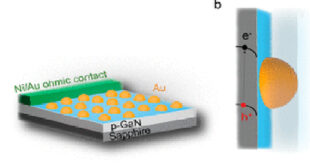Significance Statement
Recently, the reported thin film CIGS-based solar cells have achieved the highest efficiency of 21.7% among all thin film solar cells at laboratory level. Pulsed laser deposition (PLD) is an attractive way that possesses the advantages of simple to use and well-transferring the stoichiometry of target composition without post-treatment. All of these advantages are beneficial to obtain high quality and reproducible CIGS thin films at low cost and are also suitable for investigating the underlying physical mechanisms that limit the efficiency.
Comparisons of the growth mechanisms of Pulsed laser deposition processes with different laser sources are crucial to understand the characteristics of high quality CIGS thin films. In this study, the Pulsed laser deposition CIGS thin films prepared by nanosecond (ns) excimer laser and femtosecond (fs) Ti:Sapphire laser are compared to delineate the intimate correlations between the film growth mechanism and the associated plasma dynamics. Different film growth mechanisms were discussed in perspective of the laser-produced plasmas and crystal structures. The fs-PLD has successfully improved the inherent flaws, Cu2-xSe and air voids, ubiquitously observed in ns-PLD-derived CIGS thin films. Moreover, the prominent antireflection and excellent crystalline structures were obtained in the fs-PLD-derived CIGS thin films. The absorption spectra suggest the divergence in energy levels of radiative defects brought by the inhomogeneous distribution of elements in the fs-PLD CIGS, which has also been supported by comparing photoluminescence (PL) spectra of ns- and fs-PLD CIGS thin films at 15 K. Finally, the superior carrier transport properties in fs-PLD CIGS were confirmed by fs pump-probe spectroscopy and four-probe measurements. The present results indicate a promising way for preparing high quality CIGS thin films via fs-PLD.
Journal Reference
Chen SC1, Hsieh DH2, Jiang H1, Liao YK1, Lai FI3, Chen CH2, Luo CW1, Juang JY1, Chueh YL4, Wu KH1, Kuo HC2.
Nanoscale Res Lett. 2014 ;9(1):280.
1Department of Electrophysics, National Chiao-Tung University, Hsinchu 30010, Taiwan.and
2Department of Photonics and Institute of Electro-Optical Engineering, National Chiao-Tung University, Hsinchu 30010, Taiwan.and
3Department of Photonic Engineering, Yuan-Ze University, Taoyuan 32003, Taiwan.and
4Department of Materials Science and Engineering, National Tsing Hua University, Hsinchu 30013, Taiwan.
Abstract
In this work, CuIn1 – x Ga x Se2 (CIGS) thin films were prepared by nanosecond (ns)- and femtosecond (fs)-pulsed laser deposition (PLD) processes. Different film growth mechanisms were discussed in perspective of the laser-produced plasmas and crystal structures. The fs-PLD has successfully improved the inherent flaws, Cu2 – x Se, and air voids ubiquitously observed in ns-PLD-derived CIGS thin films. Moreover, the prominent antireflection and excellent crystalline structures were obtained in the fs-PLD-derived CIGS thin films. The absorption spectra suggest the divergence in energy levels of radiative defects brought by the inhomogeneous distribution of elements in the fs-PLD CIGS, which has also been supported by comparing photoluminescence (PL) spectra of ns- and fs-PLD CIGS thin films at 15 K. Finally, the superior carrier transport properties in fs-PLD CIGS were confirmed by fs pump-probe spectroscopy and four-probe measurements. The present results indicate a promising way for preparing high-quality CIGS thin films via fs-PLD.
 Advances in Engineering Advances in Engineering features breaking research judged by Advances in Engineering advisory team to be of key importance in the Engineering field. Papers are selected from over 10,000 published each week from most peer reviewed journals.
Advances in Engineering Advances in Engineering features breaking research judged by Advances in Engineering advisory team to be of key importance in the Engineering field. Papers are selected from over 10,000 published each week from most peer reviewed journals.


